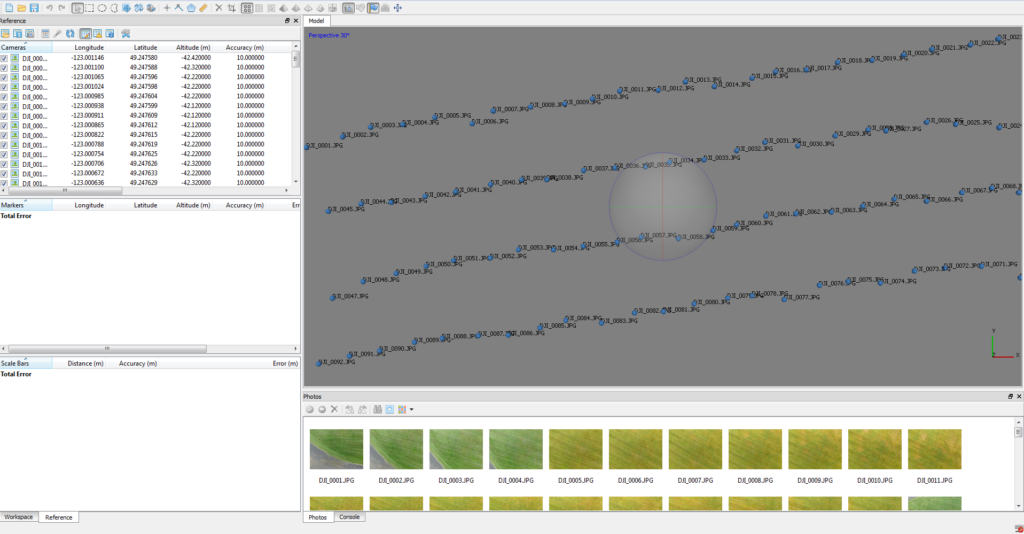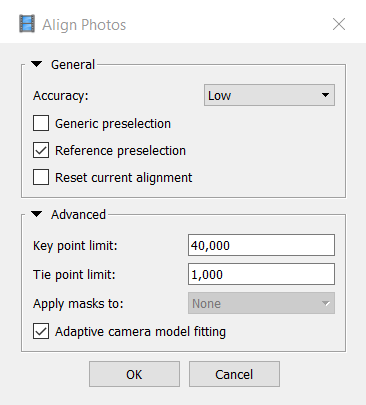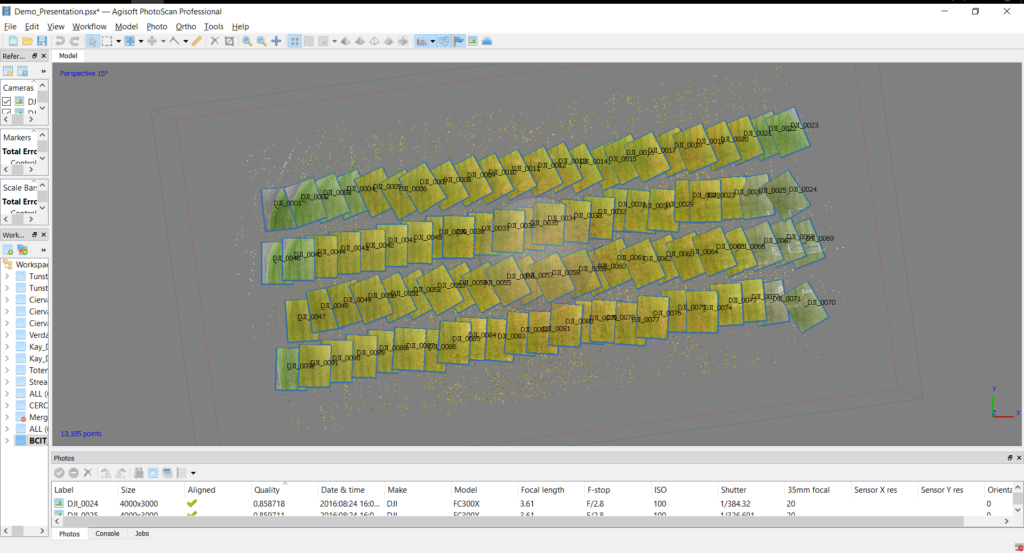Part 1 – Project Setup
Chapter 1.2 – Setting Up Images
Overview
In this chapter, the aim is to ensure that the images captured by the UAS are ready for processing in Agisoft Photoscan Professional (Photoscan). A Photoscan project will be created into which the supplied UAS images will be imported and then aligned.
Photoscan Project Setup
Download the UAS images here. Create a folder called BCIT_Field in the Documents folder on your workstation. Open the BCIT_Field folder, create a sub-folder called Images and unzip the downloaded UAS images into this sub-folder. You will have to remember the location of the Images folder. Ensure that all 92 images are present.
From the Start menu, find and launch Agisoft Photoscan Professional.
Import Photos
From the Workflow menu, select Add Photos, navigate to the Images sub-folder, select all images and click Open. Your window should look similar to the screenshot below.

All of the photos along with their longitude, latitude, altitude and estimated accuracy are listed in the top left pane. Each photo thumbnail is also visible in the bottom pane and a full resolution image can be opened by double-clicking the thumbnail.
In the main Model window, all of the image centers (principal point) are shown lined up according to how the UAS flew the pre-programmed image acquisition mission. The ball in the center of the Model window is used to rotate and spin the model in the X, Y and Z axes using the left mouse button. The right mouse button moves the model around while zooming in/out is done using the scroll-wheel on a mouse or by sliding two fingers on a touchpad.
Assess Image Quality
The first quality assurance step is to assess the quality of the input photos. Photoscan checks basic photo attributes such as motion blur, focus, contrast and exposure. Right-click on one of the photos in the bottom pane, select Estimate Image Quality…, select All Photos then switch to Detailed view to see the quality score. Scores range from 0 (unacceptable) to 1.0 (perfect) and any photos below 0.6 should not be included in further processing.
Adjust Altitude & Coordinate System
By default, the principal points at each photo center are tagged with GPS coordinates in the WGS 84 coordinate system. This means that although the horizontal position (i.e. longitude and latitude) is relatively accurate (+5m), the altitude needs to be adjusted to the actual height that the UAS flew above the ground. This is accomplished by accessing the Tools menu, selecting Scrpits and running the following Python script PS125_load_altitude_DJI.py from the C:\Program Files\Agisoft\PhotoScan Pro\python\Scripts folder.
Change Coordinate System
If the coordinate system needs to be changed from the default WGS 84, click on the Convert icon in the Reference pane and select a new coordinate system of your choice. Apply the conversion to Photos only (uncheck Markers) and click OK.
Aligning Photos
So far, the software only knows where the centre of each photo should be in absolute space (i.e. real-world coordinate system). It doesn’t yet know how all the overlapping photos connect or fit together. This is the purpose of the alignment function in Photoscan. Aligning photos is based on a computer vision concept called Structure from Motion.
From the Workflow menu, select Align Photos, adjust the parameters to match the screenshot below and click OK.

After a few seconds, the sparse point cloud showing the key tie points is generated and the view should look similar to the one below.

Save the project by accessing the File menu, selecting Save As…, navigating to the BCIT_Field folder, naming it BCIT_Field and clicking OK.

